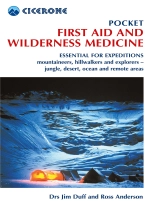This conveniently sized guide is an invaluable point of reference for all who travel and take part in outdoor, wilderness and mountain activities. Written by doctors with a wealth of wilderness specific experience, it provides a comprehensive summary of wilderness first aid and medicine – that is, managing accident or illness in remote locations without immediate access to help – giving you confidence in your ability to deal with any situation that may arise.
All topics are clearly referenced and easy to find, with chapters covering preparation, prevention, accident protocol, diagnosis, treatment and evacuation. From life-threatening emergencies to broken bones and sprains, infectious diseases, food poisoning, envenomation and respiratory problems, the book sets out all the crucial protocol and procedures to follow. It covers a wide range of different environments, including high altitude, desert, polar, tropical and marine, dealing with risk management and a variety of different scenarios. In addition, suggestions for first-aid kits and lists of medications and antibiotics (with dosage) can be found in the appendices.
Cuprins
Accident and illness protocol
Acronyms and abbreviations
Conversion tables
Preface
Read this
Part 1: The fundamentals
1. Prevention
2. Positioning and moving a victim
3. Medications – what you need to know
4. Pain management
Part 2: Accident and illness protocol
5. Accident and illness protocol in a wilderness setting
6. Primary survey – dealing with life-threatening emergencies
7. Primary survey for specific situations
8. Shock prevention and stabilization
9. Secondary survey – working out what the problem is
10. Evacuation
Part 3: Problems and their treatment
11. Spinal and head injuries
12. Burns
13. Broken bones, dislocations, sprains and strains
14. Wounds
15. Bites, stings and nasty plants
16. Cold weather problems
17. Hot weather problems
18. Dehydration
19. Diarrhoea and food poisoning
20. Abdominal (belly) problems
21. Respiratory problems
22. Altitude illness – AMS, HACE and HAPE
23. Drowning and diving problems
24. Infectious diseases
25. Eyes, ears and mouth
26. Skin problems
27. Gender-specific problems and STIs
28. Other problems
Appendix 1 Chart of medications
Appendix 2 Antibiotics
Appendix 3 Rescue request form
Appendix 4 Marine envenomation
Appendix 5 Altitude illness flowchart
Appendix 6 Lake Louise Score (LLS)
Appendix 7 Avalanche rescue flow chart
Appendix 8 The skeleton and internal organs
Appendix 9 First aid kits
Appendix 10 Useful contacts and sources of information
Index of diagrams
Index
Basic life support (BLS) in the wilderness
Despre autor
Dr Jim Duff grew up in the UK and started climbing at 14. Jim has more than 30 years’ experience of climbing, trekking and teaching wilderness medicine, first aid and leadership in the Himalaya. He was doctor on Chris Bonington’s 1975 expedition, which made the first ascent of Everest’s Southwest face, and on the Australian first ascent of the North face of Everest in 1984. As well as expeditions to K2 and Changabang, Jim has climbed in the UK, Alps, Norway, New Zealand and North America. In 1997 he founded the International Porter Protection Group (www.ippg.net) which has porter shelters and rescue posts in the Gokyo valley in the Everest region. Jim lives in Australia and teaches and lectures on wilderness medicine internationally.












